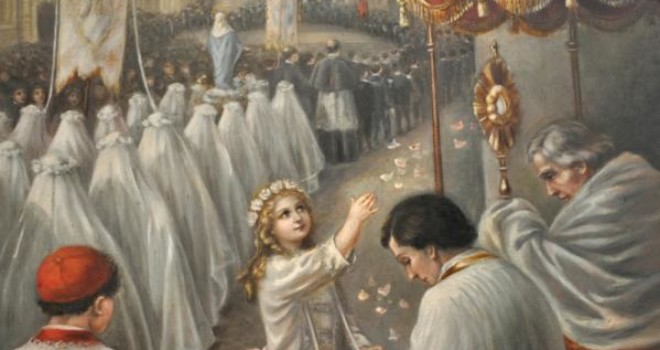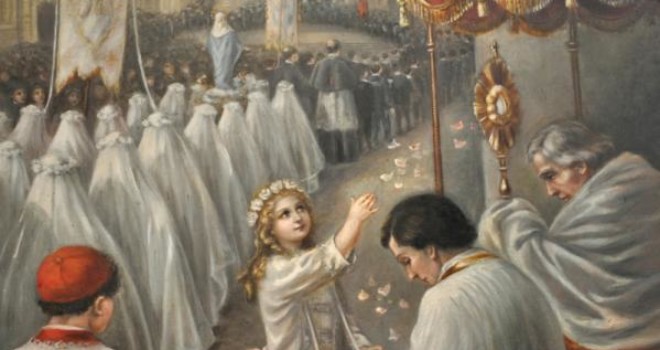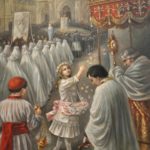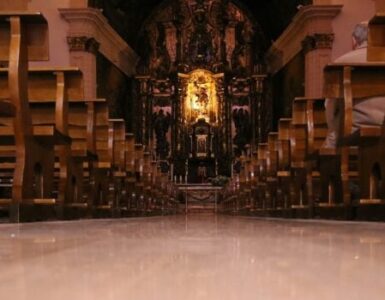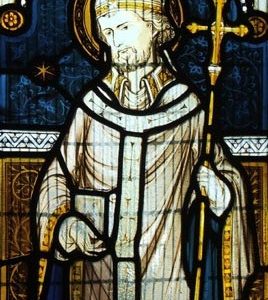In 1993, when I was sixteen, I attended World Youth Day in Denver, Colorado. One day my group attended a Holy Hour of Eucharistic Adoration with exposition led by Fr. Benedict Groeschel, CFR. Although I was raised Catholic, always attended weekend Mass and had begun attending daily Mass, this was the first time I recall making a Holy Hour. As Fr. Groeschel was talking, the realization of Our Lord’s Presence in the Holy Eucharist struck me in a new and profound way. I remember thinking: “If Jesus loves me so much that He would hide under the appearance of bread for love of me, then I want to give my life for Jesus too.”
Similar graces have occurred in the lives of many believers throughout history and continue to happen in our own day. St. Juliana of Cornillon, also known as St. Juliana of Liège (Belgium), lived in the 12th century. Orphaned at the age of five and sent to live with Augustinian nuns, she became a sister and was so learned that she could read the writings of the Church Fathers in Latin. Pope Benedict XVI, who dedicated a General Audience to her life and witness, shared that:
When Juliana was 16 she had her first vision which recurred subsequently several times during her Eucharistic adoration. Her vision presented the moon in its full splendour, crossed diametrically by a dark stripe. The Lord made her understand the meaning of what had appeared to her. The moon symbolized the life of the Church on earth, the opaque line, on the other hand, represented the absence of a liturgical feast for whose institution Juliana was asked to plead effectively: namely, a feast in which believers would be able to adore the Eucharist so as to increase in faith, to advance in the practice of the virtues and to make reparation for offences to the Most Holy Sacrament. (November 17, 2010)
For about twenty years, St. Juliana kept this experience a secret. When she confided it to others, she met with mixed reactions of support, as well as condemnation. As in the lives of many saints, she suffered persecution for a time, and even estrangement from her own community. However, St. Juliana remained faithful in her love of Jesus in the Blessed Sacrament, spending time with Him, and drawing others to the love of His Eucharistic Heart.
In 1246 St. Juliana’s Bishop, Robert of Thourette, instituted the Feast of Corpus Christi in Liège. St. Juliana had already composed an office for Corpus Christi and St. Thomas Aquinas later did as well. Then, in 1264, Pope Urban IV made this a holy day of obligation for the universal Church “hereby expressing the importance of venerating the Eucharistic Body of our Savior.” (St. John Paul II, letter to the Bishop of Liège, 750th anniversary of the institution of Corpus Christi, June 26, 1996)
The necessity for attending Mass, receiving Holy Communion, and spending time with Our Lord in Eucharistic Adoration is increasingly urgent in our age, which is why the United States Conference of Catholic Bishops are launching a National Eucharistic Revival on the Solemnity of Corpus Christi. A recently released movie “Alive: Who is There?” will be shown in select movie theaters on June 21 only. This powerful and inspirational documentary shows how individuals from various life experiences encounter Our Lord in Adoration of the Blessed Sacrament. Viewers will meet a college student who is an atheist and searching for the truth, a teenager who fell away from the faith and into serious sins, a young woman who experienced trauma and longed for healing, and a middle aged couple who struggled through difficult health news as parents. In essence, they all came to realize what St. John Paul II explained in his aforementioned letter:
“It is invaluable to converse with Christ and, leaning against Jesus’ breast like his beloved disciple, we can feel the infinite love of his Heart. We learn to know more deeply the One who gave himself totally, in the different mysteries of his divine and human life, so that we may become disciples and in turn enter into this great act of giving, for the glory of God and the salvation of the world.”
Several saints, such as Alphonsus Liguori and Peter Julian Eymard also wrote meditations in honor of Corpus Christi. Innumerable men and women in modernity also possess an ardent love for Our Eucharistic King. Many recall Venerable Archbishop Fulton J. Sheen’s fervent love of the Blessed Sacrament. He promoted a daily Holy Hour –- the Holy Hour Power –- among Catholics and non-Catholics alike “to combat the hour of evil.” In Sheen’s recently reprinted anthology War and Peace, compiler Al Smith writes of the Archbishop’s deep love of the Holy Eucharist:
“Sheen also said that ‘the greatest love story of all time is contained in a tiny white host.’ This was the love that transformed him. His daily Eucharistic Holy Hour was legendary. From the day of his ordination to the day of his death, Sheen spent an hour a day praying in the presence of the Blessed Sacrament. From his office desk, through an open door, he could gaze upon the tabernacle at all times. His union with Christ enabled him to more fully, more accurately and more convincingly lead others to Christ in all he said and did. Sheen was a man of many talents and accomplishments, but it was Christ who enabled him to use them in the best ways.”
Eucharistic processions are also an important testament to our belief in the Real Presence of Jesus in the Blessed Sacrament and have spurred multiple conversions. Prior to St. Elizabeth Ann Seton’s entrance into the Catholic Church, Eucharistic processions passed by her home on several instances. She expressed her longing for the Holy Eucharist in a letter to a friend:
“How happy we would be if we believed what these dear souls believe: that they possess God in the Sacrament. . . . When they carry the Blessed Sacrament under my window. . . . I cannot stop the tears at the thought. My God how happy I would be. . . if I could find you in the church as they do.”
St. Elizabeth would often turn her chair when attending the Protestant Church to face the Catholic Church and be closer to Jesus in the Blessed Sacrament. Once, when attending Mass with a Catholic friend, she knelt at the elevation and thought of St. Paul’s words “they discern not the Lord’s body.” Despite the opposition of her family, her yearning for Our Eucharistic Lord was so strong that she entered the Catholic Church.
Blessed Niels Steensen – a pioneer in anatomy and geology – became so convinced of the need to give himself entirely to our Lord in the Holy Eucharist that he converted to Catholicism and soon became a priest. He writes of this miraculous transformation:
“[I] observed with curiosity and perplexity the Corpus Christi procession and the fervor surrounding it. Banners and tapestries were swinging in the gentle breeze coming from the sea…Petals and flowers rained down on all sides… how I could do nothing but offer Him the best of myself.”
Blessed Niels recalled some of his Jesuit friends sharing with him about the importance of the Last Supper and the belief of Catholics in the Real Presence of Jesus in the Holy Eucharist.
In her autobiography Story of a Soul, St. Thérèse of Lisieux recalls her joy as a child when venerating Our Lord in the Holy Eucharist:
“I loved especially the processions in honor of the Blessed Sacrament. What a joy it was for me to throw flowers beneath the feet of God! Before allowing them to fall to the ground, I threw them as high as I could, and I was never so happy as when I saw my roses touch the sacred monstrance.”
May this Eucharistic joy be rekindled in our hearts as we celebrated the Feast of Corpus Christi. During this time of revival may we become sentinels of the Blessed Sacrament for God’s glory and the salvation of souls, mindful of the words of St. John Paul II:
“Through adoration, the Christian mysteriously contributes to the radical transformation of the world and to the sowing of the Gospel. Anyone who prays to the Savior draws the whole world with him and raises it to God. Those who stand before the Lord are therefore fulfilling an eminent service. They are presenting to Christ all those who do not know him or are far from him: they keep watch in his presence on their behalf.” (Letter to the Bishop of Liège, June 26, 1996)
✠
Image: St. Thérèse of Lisieux venerates the Blessed Sacrament


